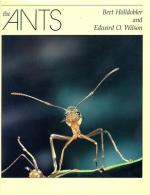|
This section contains 587 words (approx. 2 pages at 400 words per page) |

|
Chapter 7 Communication Summary
Ant communication is categorized into twelve broad functional groups: alarm; attraction; recruitment (a form of assembly where individuals are directed to a place where work is required); grooming; trophallaxis (the exchange of alimentary liquid among colony members); food exchange; group effect; recognition; caste determination; control; territorial signals; and sexual communication.
Chemical ("pheromone") communication is the predominant method utilized by all ant species. Glandular sources of chemicals used for communication are extensively discussed. Numerous photographs, photomicrographs, and illustrations are accompanied by text, which describes the extensive variety of chemical-producing glands found in various ant species.
The molecular design of ant pheromones is considered in general. The efficiency of chemical signaling is reviewed. Various lab assays of ant pheromones are presented, including chemical formulas for some pheromones. Several species are considered in greater detail.
The theory of ritualized communication is presented in general...
(read more from the Chapter 7 Communication Summary)
|
This section contains 587 words (approx. 2 pages at 400 words per page) |

|




